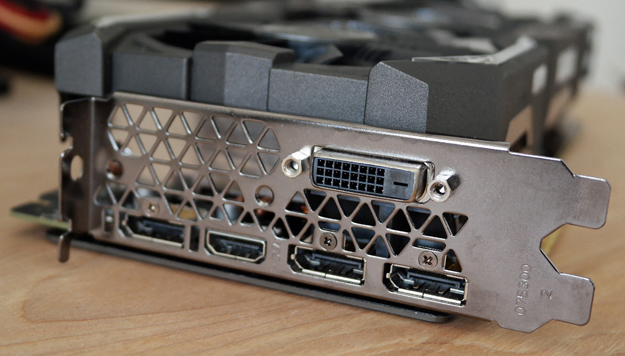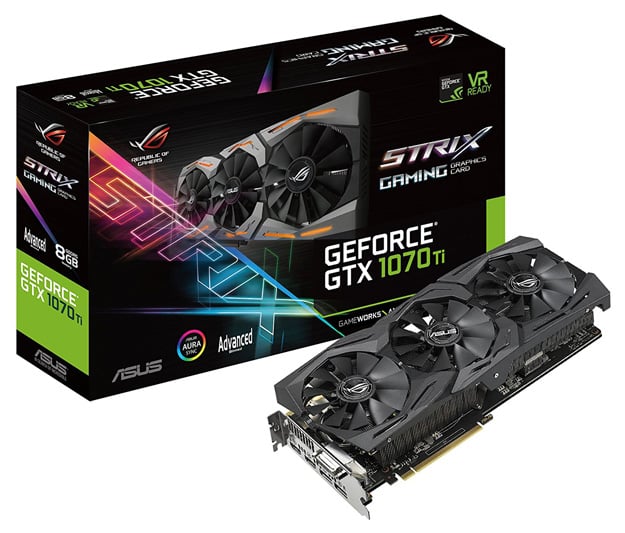NVIDIA GeForce GTX 1070 Ti Shoot-Out: ASUS Strix And Zotac AMP Extreme
GeForce GTX 1070 Ti Face Off Asus Strix & Zotac AMP Extreme
It is very likely that NVIDIA’s GeForce GTX 1070 Ti will be the final Pascal-based desktop GPU to arrive for gamers, before next-generation architectures hit the scene in the not too distant future. As most of you probably know, the GeForce GTX 1070 Ti targets enthusiasts and hardcore gamers and is positioned in the narrow gap between the GTX 1070 and GTX 1080. We took an extended look at NVIDIA’s Founders Edition card in our launch coverage. But here we’re turning our gaze toward a couple custom variants from Zotac and ASUS.
In this piece we're pitting the Zotac GeForce GTX 1070 Ti AMP Extreme Edition against the ASUS ROG Strix GTX 1070 Ti. Each card features the same GPU with 2,432 CUDA cores with a Boost Clock of 1683MHz and a Base Clock of 1607MHz, though higher clocks are offered via software tweaks as we'll show you later. The customary 8GB of GDDR5 memory, clocked at 8GHz, is also found on each offering.
The custom cooling hardware and varied designs will mostly dictate the performance variance between these two GPUs. On the following pages we will outline those variances across our suite of both synthetic and in-game benchmarks. But first let’s take a closer look at the cards themselves, including the custom cooling options, ports, and aesthetics of each. Then we can skip onto the performance numbers before dabbling in a bit of overclocking and evaluating power consumption.
|
| Graphics Processing | GeForce GTX 1070 Ti |
| Core Clock | Boost: 1683 MHz / Base: 1607 MHz |
| Memory Clock | 8GHz |
| Memory Size | 8 GB |
| Memory Type | GDDR5 |
| Memory Bus256 | 256 bit |
| Output | 3 x DisplayPort 1.4, HDMI 2.0b, DL-DVI-D |
| Digital max resolution | 7680x4320 |
| Card size | 12.8in x 5.83in x 2.23in |
| Recommended PSU | 600W |
| Power Connectors | PCIe 8-pin x 2 |
| Pricing | $599 MSRP -- Currently $969 On Amazon |
The Zotac GeForce GTX 1070 Ti AMP Extreme is the company’s high-end, factory overclocked and custom cooled 1070 Ti. It sports the aforementioned Base and Boost clocks speeds (1607MHz/1683MHz). However, our overclocking section reveals there is plenty of additional performance lurking under the hood.
Zotac has employed its “IceStorm Cooling” system with "EKO fans" here. Between the metal shroud housing the fans, and the wrap-around style backplate, are the heat pipes and heat sink fin array. This system uses direct contact between the heat pipes and the copper GPU baseplate, to pull heat away from the GPU. Within the metal fan shroud, the three patented EKO fans are dual-blade designs that help to move more air, more efficiently than the Founder’s Edition variants that have only a single barrel-type fan. Emblazoned with the company logo and signature colors, the backplate and fan shroud add considerable bulk to the AMP Extreme 1070 Ti, so choose your motherboard and enclosure options wisely, especially if SLI is your goal -- one of these cards will cover three slots on its own.
You may notice that the Zotac AMP Extreme requires two 8-pin power cables. This is unlike both the Founder Edition and the competing ASUS ROG Strix 1070 Ti. Those other cards only require a single 8-pin power cable. Zotac incorporated the additional power feed to ensure stability when overclocking beyond the factory specs. There are additional capacitors on-board to further filter and smooth power delivery as well. Finally, for display connectivity, we have 3 x DisplayPort 1.4 ports, HDMI 2.0b, and a DL-DVI-D connection.
Spectra is the name Zotac gives to the card's custom lighting setup. It illuminates the four sections around the front of the fan shroud as well as the section just above the middle fan and a portion of the backplate. Colors and lighting features can be managed with the included Firestorm application from within Windows.
|
| Graphics Processing | GeForce GTX 1070 Ti |
| Core Clock | Boost: 1749 MHz / Base: 1683 MHz in OC mode Boost: 1683 MHz / Base: 1607 MHz in Gaming mode (Default) |
| Memory Clock | 8 GHz |
| Memory Size | 8 GB |
| Memory Type | GDDR5 |
| Memory Bus | 256 bit |
| Output | DVI Output: 1 x (Native) (DVI-D) HDMI Output: 2 x (Native) (HDMI 2.0), Display Port: 2 x (Native) (Regular DP), HDCP Support |
| Digital max resolution | 7680x4320 |
| Card size | 11.73" x 5.28" x 2.07" Inch |
| Recommended PSU | 600W |
| Power Connectors | PCIe 8-pin x 2 |
| Pricing | $679 MSRP - Currently $844 On Amazon |
The ASUS ROG Strix GeForce GTX 1070 Ti is factory overclocked and outfitted with its own custom cooling solution. It features the same Base and Boost clocks speeds (1607MHz/1683MHz) in hardware. However, using the included software, the ASUS model can be quickly switched from the default Game Mode to OC Mode, which boasts a Base Clock of 1683MHz with a Boost Clock of 1759MHz. Still, we will be manually dialing in more extreme custom overclocked settings to better gauge OC performance in the pages to come.
While not as thick and hefty as the AMP Extreme, the ASUS ROG Strix is still constructed with a 2.5 slot width. This offers more surface area for the heatsink, which is part of what comprises the company’s MaxContact cooling technogy. This cooling system has the heat spreader and heat pipes sit in direct contact just above the GPU to pull heat away as efficiently as possible. The three fan shroud incorporates patented “Wing-Blade” fans that are IP5X-certified for dust resistance.
For added system cooling, ASUS also incorporates its FanConnect II feature, which adds two 4-pin headers to the board for connecting additional PWM and DC system fans. Preset cooling profiles and controls can be managed at the desktop using the included GPU Tweak II software utility.



















